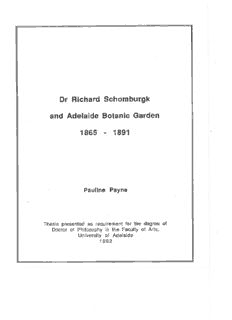
Dr Richard Schomburgk and Adelaide Botanic Garden 1865-1891 PDF
Preview Dr Richard Schomburgk and Adelaide Botanic Garden 1865-1891
Dr Richard Schomburgk and Adelaide Botanic Garden 865 891 1 T 1 Pauline Payne Thesis presented as requirement for the degree of Doctor of Philosophy in the Faculty of Arts, University of Adelaide 992 1 For Jean Mary Schomburgk with affection and gratitude Contents lllu stratio n s Abbreviations ¡¡¡ Abstract iv Declaration VI vll Acknowledgements iii I n trod u ctio n v Chapter The role of the Botanic Garden 1 1 Garden Chapter 2 A new settlement and a new Botanic 3 3 Chapter 3 Richard Moritz Schomburgk 103 4 Chapter Developing the Botanic Garden site 167 Chapter 5 Scientif ic and utilitarian gardening 245 I Part Grasses and fodder plants Chapter 6 Scientif ic and utilitarian gardening 321 ll Part Other useful plants 7 Chapter Schomburgk and the plant sciences 433 Chapter B Adelaide Botanic Garden as an educational institution 532 Chapter 9 Schomburgk as Director 574 Conclusion 630 Bibliography 645 ILLUSTRATIONS 1. Entrance to the Botanic Garden following p. 92 2. The first Main Gates in North Terrace following p. 100 3 Richard Moritz Schomburgk following p. 102 4. Botanic Gardens centre walk following p. 166 5. Plan of Botanic Garden site 1874 following p. 170 6. The Aquarium following p. 170 7. Cages for animals and birds following p. 171 8. Parterre near the entrance gate following p. 173 o View across Botanic Garden towards the Royal Adelaide Hospital following p. 180 10 The Rose Garden following p.182 11. View of eastern part of Garden following p. 188 12. Victoria House following p. 195 13 Palm House following p. 224 14 Interior of Palm House following p. 227 15 View from Palm House terrace following p. 228 16 Museum of Economic Botany following p. 232 17.' The large fountain on Main Walk following p. 233 18. Experimental Garden following p. 320 [Photographs from Botanic Garden archival collection with kind permission of the Director and Board of Adelaide Botanic Gardens. Engravíngs from Richard schomburgk's catatogue of plants under cultivation in Adelaide Eotanic Garden, Adeiaicie 1979, Botanic Gardens centre walk illustration from Annual Report 1gg6.l ill Abbrev¡ations A.B.G. Adelaide Botanic Garden cwt. hundredweight (weight) ft. oot/f eet f tb. pounds (weight) M.LC. Member of the Legislative Gouncil N.S.W. New South Wales N.T. Northern Territory Qld. Queensland S.A. South Australia sp. species spp. species (plural) Tas. Tas man ia var. variety Vic. V icto r ia W.A. Western Australia v It will be argued that there were certain cultural factors in Adelaide soc¡ety that played an important part in the support given to Schomburgk and the gardens. This case study demonstrates how the cultural milieu atfected the work of a colonial scientist. Of these factors relating to cultural milieu, three stand out: openess to new ideas, a desire to obtain 'the best available' for South Australia and alongside this a desire for 'respectability'. A further theme of the thesis relates to the transfer of plant mater¡al: its importance to Australia and its place in British imperial development. Schomburgk's approach was an international one. Probably the largest importer of plant mater¡al in Australia in his day he used international botanical contacts to obtain plant material (e.9. for wheal, sultanas, almonds) which benefited all Australian colonies. His contacts with colleagues in Germany, where he had been a prolégé of the great nineteenth century geographer and scientist, Alexander von Humboldt, provided a link belween scientific developments in Australasia and research in Germany. While scientific links with British colleagues were of great importance, Schomburgk's pragmatic approach saw him forging extra- imperial links with colleagues in continental Europe, North and South America and Java. The. Botanic Garden, one of the earliest scientific institutions in Australia, provided a beachhead for scientific development. A study of Schomburgk's career provides some insight ¡nto the role of one of Australia's first professional scientific workers and into a worldwide network of exchange for information and plant material. vlt Acknowledgements I am very grateful to the staff and Board of the Adelaide Botanic Garden, and especially for the help of Dr Brian Morley, Dr Lauri Haegi, Dr Bill Barker, Robin Barker, Nigel Turner, Trevor Christensen, Theckla Reichstein and the Technical Section. David Symon and Gaye Denny made a special contribution. Their help and support and that of their colleagues made the years of research at Adelaide Botanic Garden very happy ones and I thank them all. I would also like to acknowlege the help of Professor lan lnkster, Professor R. W. Home, Professor Brian Dickey, Professor Roy Macleod, Dr Bill Gammage, Associate Professor Tony Denholm, Dr Linden Gilchrist, Dr Ann Moyal, Dr Ann Daughtry, Margaret Hosking, Dorothy Hudson, Nigel Hart, Vera Baghurst, Danielle James, Doris Turner, Elaine Barker, Jean Schomburgk and lan Schomburgk, each of whom made particular contributions at various stages of the project. Very special thanks are owed to Emeritus Professor Austin Gough whose scholarship and cheerful support played such an important part ¡n making the production of the dissertation so enjoyable. My thanks too, to the staff and post-graduate group in the H¡story Department of the University of Adelaide. Finally, sincere thanks to Peter Payne, Penelope Deutscher and Pepita Payne for their faith that this project would reach completion.
Description: